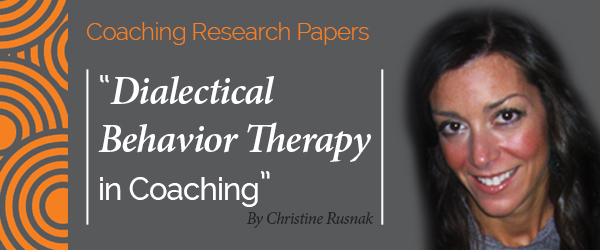 Research Paper By Christine Rusnak
Research Paper By Christine Rusnak
(Life and Wellness Coaching, UNITED STATES)
Introduction
Life coaches support individuals in making fundamental changes in their lives, whether its accomplishing specific goals, attaining a life-long dream, making a career or relationship change, or simply finding a purpose in life. And it is not uncommon to observe that this exploration brings up a variety of feelings and emotions for the client. In Co-Active Coaching, the technique of process coaching includes the fact that
one aspect of process coaching that is hard for many coaches is being with the emotion of it. The exploration touches deep feelings in clients – feelings they often express emotionally as well as verbally. (Whitworth, Kimsey-House, & Sanddahl, 1998, pg. 150).
Although it is normal and healthy for the client to experience heightened emotions related to a situation at hand, it can present difficulties if the client demonstrates tendencies to become fully engulfed and overwhelmed by their emotions. When strong, intense, or out of control emotions are felt by the client, it can be very easy for them to get hooked into them and completed absorbed by the feelings, creating a barrier to making healthy, effective decisions. Life coaches may see that their clients have difficulties working on their goals between sessions due to the fact that they are letting their strong emotions take over, creating an additional “obstacle” to putting all of the positive energy created in the coaching session to effective use.
Studies have shown that the techniques of Dialectical Behavior Therapy (DBT) have been effective at helping individuals manage overwhelming emotions (Linehan, 1993). The purpose of this paper is to discuss how modification of various components of Dialectical Behavior Therapy (DBT), such as dialectical theory, mindfulness, and distress tolerance, can be useful conceptual tools to include in coaching sessions when the client is faced with situations that are creating heightened emotions.
What is Dialectical Behavior Therapy (DBT)?
Dialectical Behavior Therapy (DBT) is an “acceptance-based approach” that was developed in 1993 by Marsha Linehan, a psychology researcher at the University of Washington, as a form of cognitive-behavioral therapy targeted to treating individuals who have significant difficulty regulating their emotions, leading to harmful or destructive behaviors. Although Linehan’s work was originally created to treat women who were chronically suicidal, it has grown to become an evidence-based treatment for adults diagnosed with Borderline Personality Disorder. Research has shown that DBT strengthens a person’s ability to handle distress without losing control or acting out destructively (McKay, Wood, & Brantley, 2007). Studies have further indicated that DBT is effective in treating a variety of patients who present with varied symptoms and behaviors associated with depression, mood disorders, self-injury behavior, eating disorders, chemical dependency and sexual abuse.
DBT is founded on the belief that both environmental and biological factors cause some people to experience emotional states at a faster rate, and in greater degree, than typical. These individuals then seem to stay in a heightened emotional state for an extended period of time, creating a barrier to engaging in safe and healthy coping strategies. These individuals lack the ability to accurately label and regulate their emotional arousal, to effectively tolerate their emotional distress, or to even trust their emotional response as “valid.” Without proper skills, the intense emotions can take over and become problematic, rather than serve, the individual (Linehan, 1993).
The DBT framework is based on combining basic theories of behavioral therapy with eastern mindfulness practices, overarched by theories of dialectical thinking, which holds the view that opposites actually have commonalities, and although they are exclusive from one another, they are, in truth, simply parts of a whole. Within DBT, individuals can learn skills with a dialectical basis within four primary modules: Mindfulness, Distress Tolerance, Emotional Regulation, and Interpersonal Effectiveness. Within each of these modules are a variety of concepts, tools and strategies that support the development of effective coping skills. Therapy is structured into three delivery modes: Individual therapy sessions primarily address the patient’s motivational issues and work to strengthen the skills learned within the four modules. DBT group sessions are arranged for further skill training and “practice” with others. Finally, telephone counseling sessions are set up between the patient and therapist to address generalization of the learned DBT skills.
How can Dialectical Behavior Therapy be adapted for use in coaching?
The Dialectical Approach
Dialectical Behavior Therapy focuses on “behaving deliberately, tolerating distress, and acting with mindful awareness of what you are experiencing and what’s best for you” (Neziroglu & Donnelly, 2010). A coach can use the dialectical approach by reminding the client to synthesize their intellect and their emotions to develop healthy strategies and coping techniques. In The Stress Response, Christy Matta describes examples of dialectical thinking as “accepting that you feel alone at the same time that you are surrounded by people,” or “doing the best you can while acknowledging that you need to try harder.” Matta suggests that adopting dialectical thinking, believing that two contradictory beliefs can also be true at the same time, can create greater cognitive flexibility. It is observed that those who demonstrate cognitive rigidity (that there is only one, undeniable truth) often experience anxiety that quickly develops into chronic stress and significant anxiety. Therefore, the DBT therapist will foster dialectical thinking for the patient by moving them from an “either-or” mindset (or often referred by coaches as “black-or-white” thinking) to a dialectical-based “both-and” mindset, with attention to combining a state of acceptance with a willingness to change. In Overcoming Depersonalization Disorder, the authors point out that this way of thinking does not involve the client seeing “shades of grey” as a way to combat black-or-white thinking, but rather, helping the client see the white in the black and the black in the white (Neziroglu & Donnelly, 2010).